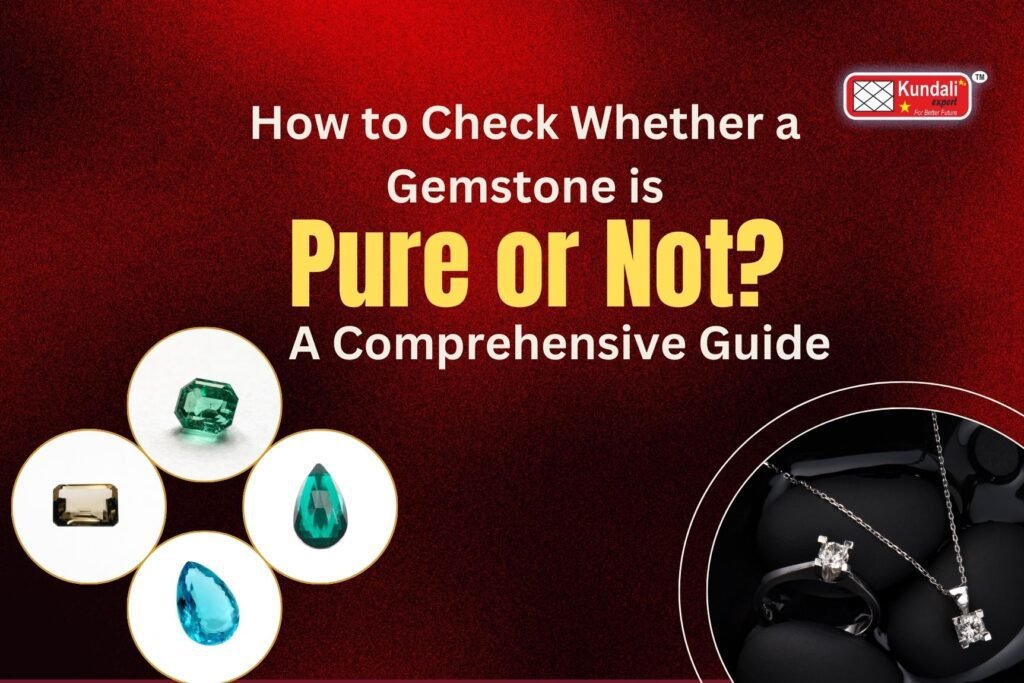Gemstones have captivated human fascination for millennia, not only for their beauty but also for their supposed metaphysical properties. Whether for adornment or astrological benefits, the purity of a gemstone is crucial. A pure gemstone is more effective in terms of its energy and properties. This guide outlines the various methods and criteria to determine the purity of a gemstone.
- Visual Inspection
Clarity and Inclusions
- Clarity: Pure gemstones should have minimal inclusions or internal flaws. Look for any visible inclusions, cracks, or cloudiness. Use a jeweler’s loupe (10x magnification) to examine the stone.
- Inclusions: These are natural imperfections within the stone. While some inclusions are expected, an abundance can indicate lower quality.
Color
- Consistency: Pure gemstones typically exhibit uniform color throughout. Variations or patches may suggest impurities.
- Vibrancy: The color should be vivid and rich. Faded or dull stones may be of lower quality.
Cut
- Precision: The cut of the gemstone should be symmetrical and well-proportioned. A well-cut gemstone reflects light evenly, enhancing its brilliance.
- Finish: The facets should be smooth and polished without visible abrasions or uneven surfaces.
- Professional Certification
Download the KUNDALI EXPERT App
Gemological Institutes
- Certificates: make sure it comes with a certificate from the official gemological institutes or certification departments. These certificates provide detailed information about the gemstone’s quality, including clarity, color, cut, and carat weight.
- Reports: The certification report includes a unique identification number, which can be used to verify the gemstone’s authenticity and quality.
- Testing Methods
Refractive Index (RI)
- Tool: Use a refractometer to measure the gemstone’s refractive index, which indicates how light bends as it passes through the stone.
- Reference: Compare the measured RI with standard values for the specific type of gemstone. Deviations may indicate impurities or synthetic origin.
Specific Gravity (SG)
- Tool: A hydrostatic balance can measure the specific gravity of the gemstone.
- Procedure: Weigh the gemstone in air and then in water. The difference in weight helps calculate the SG, which should match the known values for pure gemstones.
Spectroscopy
- Tool: A spectroscope analyzes the light spectrum emitted or absorbed by the gemstone.
- Analysis: Different gemstones have unique spectral lines. Any deviation from the expected pattern can indicate impurities or synthetic materials.
- Advanced Techniques
UV Fluorescence
- Tool: Use a UV lamp to examine the gemstone under ultraviolet light.
- Response: Pure gemstones exhibit specific fluorescence patterns under UV light. For instance, diamonds typically show a blue fluorescence. Anomalies can suggest treatments or impurities.
Thermal Conductivity
- Tool: A diamond tester measures thermal conductivity.
- Application: This test is particularly useful for diamonds, as they have high thermal conductivity compared to most imitations.
Microscopic Examination
- Tool: A high-power microscope can reveal minute details within the gemstone.
- Inspection: Look for natural growth patterns, inclusions, and any signs of artificial enhancements or treatments.
- Common Treatments and Enhancements
Heat Treatment
- Effect: Enhances color and clarity but may reduce the gemstone’s value.
- Detection: Look for signs of melting or color concentration around inclusions.
Fracture Filling
- Effect: Fills cracks and enhances clarity.
- Detection: Under magnification, filled fractures may have a glassy appearance or show different colors in reflected light.
Dyeing
- Effect: Enhances or changes the color.
- Detection: Uneven color distribution or dye concentrations in cracks and fissures.
- Practical Tips
Seek Expert Advice
- Gemologists: Consult a certified gemologist for an expert evaluation.
- Jewelers: Reputable jewelers often have the expertise and tools to assess gemstone purity.
Purchase from Reputable Sources
- Vendors: Buy from reputable dealers who provide certification and guarantees of authenticity.
- Returns: Ensure the vendor has a clear return policy in case the gemstone does not meet the expected standards.
Conclusion
Determining the purity of a gemstone requires a combination of visual inspection, professional certification, and advanced testing methods. While some aspects can be evaluated at home, seeking the expertise of certified gemologists and purchasing from reputable sources ensure the gemstone’s authenticity and quality. Understanding these criteria and methods helps buyers make informed decisions, ensuring they acquire gemstones that are not only beautiful but also pure and effective.

